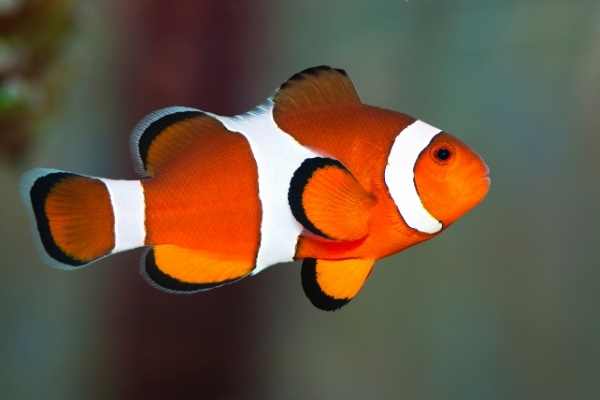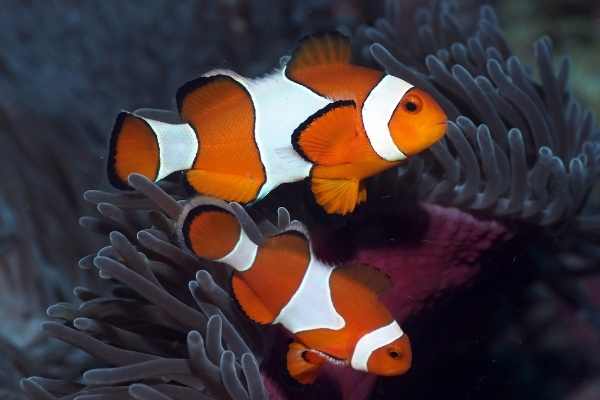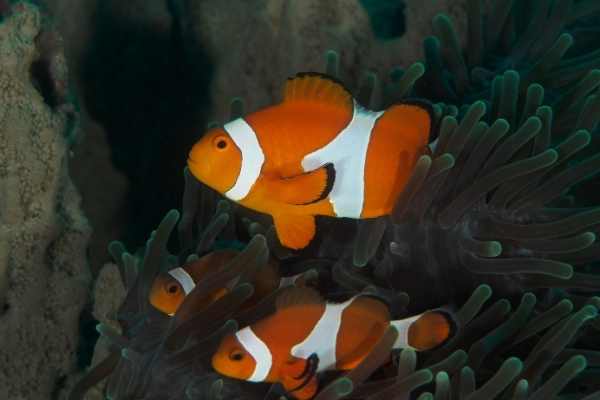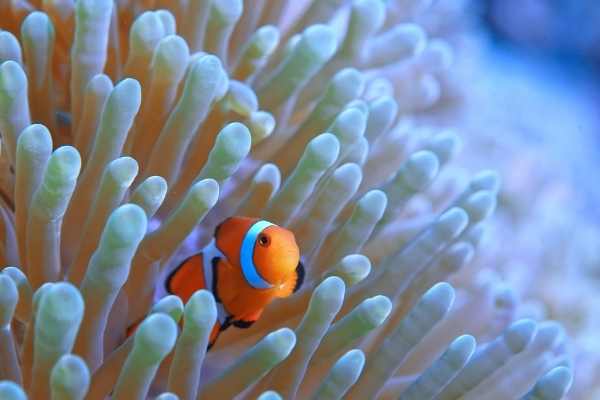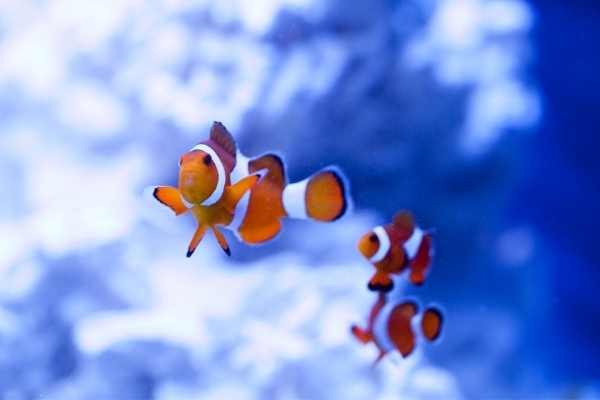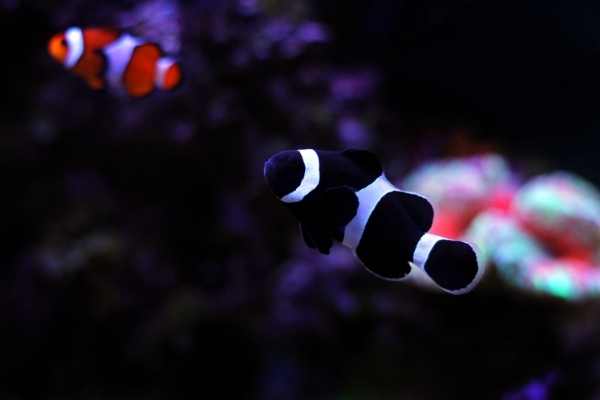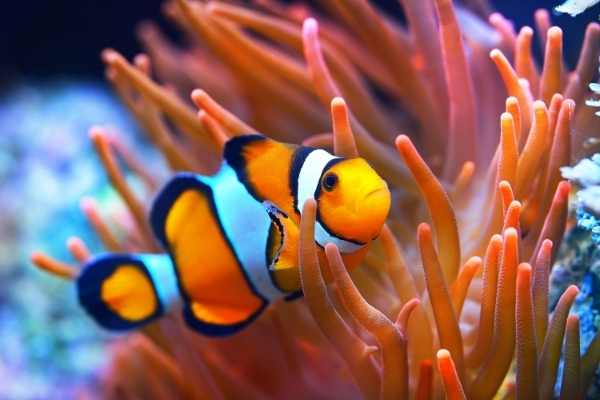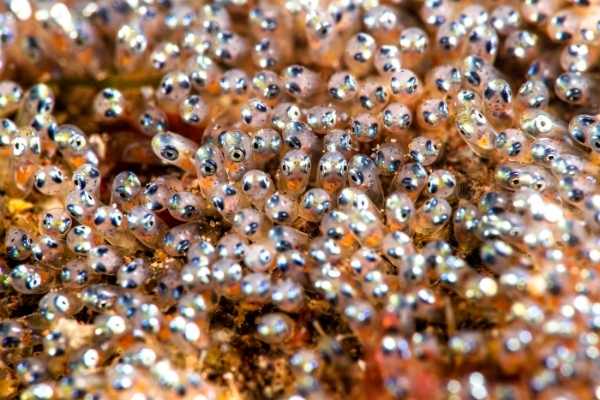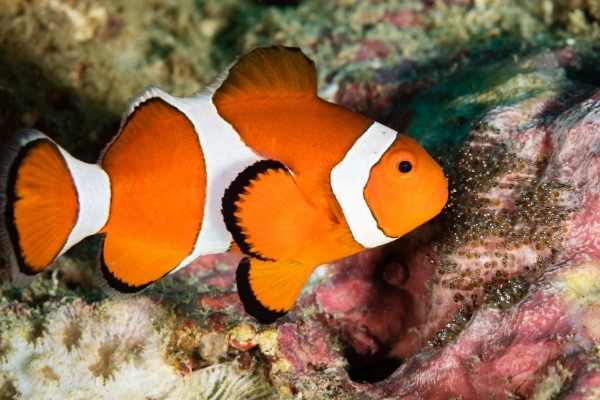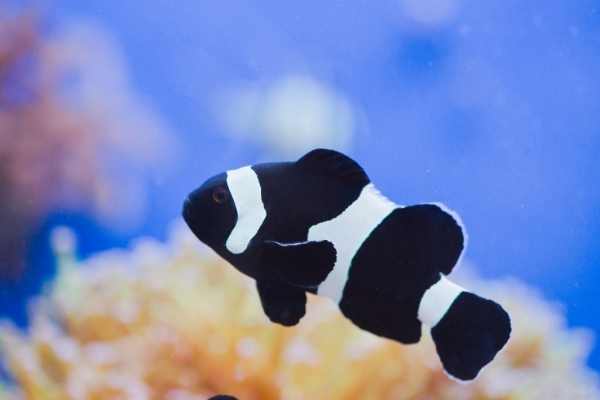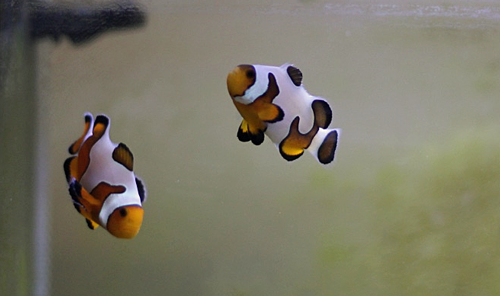[ad_1]
Amphiprion ocellaris, also known as the Ocellaris Clownfish, has become one of the most well-known and most popular saltwater aquarium fish species. These waddling and adorable striped fish have been legendary, for years, and their prominent role in movies like Finding Nemo and Finding Dory have all but cemented their place in the Saltwater Fish hall of fame. But this fish isn’t so popular among reef tank owners because of a Children’s animated movie, they are “common” for a reason–they’re perfect for the home aquarium. Let’s take a closer look at what it takes to care for the Ocellaris Clownfish.
Table of contents
If you have a specific question, you can use the Table of Contents below to jump right to it or read the rest of the article.
Quick Facts About the Common Clownfish:
- Scientific Name: Amphiprion ocellaris
- Common Names: Ocellaris Clownfish, False Percula Clownfish, Common Clownfish, Nemo
- Max Size: ~3-3.5 inches (7.6 – 9 cm), with females significantly larger than males
- Minimum tank Size: 10-gallons (~38 liters)
- Aggression Level: Peaceful & suitable for community aquariums
- Care Level: Easy
- Diet: Omnivores
- Lifespan: 15+ years
Natural habitat: where do Ocellaris clownfish live?
The natural habitat of Amphiprion ocellaris is on reefs from the Western Pacific Ocean and Eastern Indian Ocean, where they are typically found nestled in closely with their host anemone, seldom straying more than a few meters from the protection of their stinging tentacles. Their mutualistic relationship with these stinging cnidarians that would otherwise gladly make a meal of other saltwater fish, how this relationship began, why and how it even came to be are some of nature’s great mysteries, and undoubtedly one of the reasons the clownfish’s status is the king of the reef, rather than just a jester.
Life cycle
The vibrantly-colored, orange, white and black Ocellaris clownfish you see on this page all started out as tiny, transparent larvae that looked like small pieces of glass, that broke out of their eggs after a time period of about 8-10 days, depending on the temperature of the water. After hatching, they swim towards the surface of the ocean, drawn by the moonlight, where they will feast, as larvae, on the ocean’s bounty (plankton), for about 1-2 weeks, until they transform (undergo a metamorphosis) from larvae into juvenile fish.

Without access to the ocean, I had to try and create favorable conditions for the planktonic larvae to thrive. The water is green due to a high density of phytoplankton in the water which helps ensure the food the clownfish larvae are eating are nutritious
As a juvenile fish, the young False Percula Clownfish gives up life drifting among the plankton to settle down and find an anemone home of their own. If they are lucky, they will find a mate and continue the cycle.

Just a few days later, the previously tiny glass shards are much bigger and start to look more like tiny clownfish
All clownfish, including Amphiprion ocellaris, are hermaphrodites and are capable of becoming either male and female. But they aren’t able to flip flop back and forth. The gender changes happen predictably, in a one-way direction. Among any small, local population of Ocellaris clownfish, the largest, most dominant individual will be the reproducing Female. She will have a single, mature male mate. All the other fish will be small or immature males.
If the female is lost, the fish will establish a new pecking order, with one of the males becoming female. The most likely scenario is that her male mate will reprise the role of matriarch, assuming the previous pecking order is maintained and not upset by a rival.
The new pair will bond and eventually begin spawning and protecting a clutch of eggs about every 2 weeks, and the cycle continues.
Clownfish and anemone relationship
So how does the relationship between a clownfish and their anemone work, anyway? The truth is, we don’t fully know, just yet. There have been several different theories, but to my knowledge, none of them, as of yet, have been fully proven, nor have rival theories been disproven. To better explore the theories and how this might work, let’s dive a little deeper into the topic.
Anemones are normally fish killing machines. Their tentacles have specialized cells, called nematocysts, which are designed to inject would-be prey with paralyzing chemicals when triggered, typically when prey touches the area with the nematocyst.
So how does it work? Are clownfish immune to the sting? Does the anemone hold back on the sting deliberately and not pull the trigger? If so, what is the mechanism? Do the clownfish send a signal that says, “Fish are friends, not food?” Or maybe the slime coating a clownfish’s scale either insulates them against the sting, rendering it harmless, or prevents detection and stinging, the first place?
Even if the secret is in the mucus, as many are concluding, is the clownfish born with this ability, or is it acquired? Is it universal to all anemones or just the individuals they associate with? Do they need to warm up or can they dive right in? Not sure we know the answers yet, to all of these questions, and I’m not sure we need to understand in order to observe, be amazed, and enjoy.

They make it look so cozy in there.
Clownfish care in an aquarium
The Ocellaris clownfish is peaceful, generally hardy, and does well in a home aquarium. Let’s look a little more closely at what it takes to care for them in an aquarium.
Minimum tank size
Ocellaris clownfish are relatively small and don’t swim very well. As such, you could keep them, and even potentially breed them, in a 10-gallon tank, as long as you didn’t stock the tank too heavily. A tank that small will be prone to salinity swings, due to evaporation, and water parameter deterioration, if not carefully monitored and maintained, but it is probably just enough space to keep a pair of False Percula Clownfish.
With that said, there is no reason you have to keep them in a tank that small, they will do great in a large aquarium as well.
Are they reef safe?
Amphiprion ocellaris is a reef safe saltwater fish. They will not bother corals, clams, or other invertebrates. The only thing they may do that might be slightly problematic is to treat one of your corals as a surrogate anemone. This is always an adorable behavior to watch. Most times, it is fine and doesn’t cause any problems, but occasionally, the constant attention from your clowns may annoy your coral to the point it retracts its polyps and may ultimately decline as a result of the attention.
I don’t think this relatively small risk is enough to warrant a pause in considering them for your tank, but you may want to watch if your clownfish does adopt a friend.
This is a picture of the ocellaris clownfish in my reef tank at home. They adopted a Toadstool coral that was completely fine with the arrangement.

The clownfish up top was actually a baby, born and raised at home from a batch of eggs in 2011. Please ignore the cyano on the sand… :/
Water chemistry
False Percula clownfish are not picky about their water chemistry, assuming it approximates reef quality. Here are the standard values you should aim for:
- Temperature: kept stable, but between 73-84 Fahrenheit, 22.8 – 28.8 Celcius
- pH: kept stable, but between 8.1-8.4
- Specific gravity: 1.025
- Ammonia, Nitrites, Nitrates: 0 ppm
With that said, those are ideal parameters, but based on my personal experience, Ocellaris clownfish are tolerant of some fluctuation and less than ideal conditions. That doesn’t mean we are not still responsible to do our best to meet their husbandry needs, but for those of you who are new to the hobby or unsure about keeping a saltwater tank, you should be reassured that Amphiprion ocellaris is a great choice, because they can ‘work with you’ while you figure things out.
Feeding
False Percula clownfish are generally hardy eaters, eager to accept whatever food is offered. Most of the fish I have seen come from aquaculture (meaning they were born and raised in aquarium conditions, not collected from wild reefs), and they have therefore been acclimated to taking prepared foods for quite some time.
Nutritionally, they are omnivores and will do best, when presented with a variety of food options, including live foods like blackworms and brine shrimp, frozen foods like mysis shrimp or omnivore diets, as well as flakes and pellets.
Check out this article to learn how to hatch your own live brine shrimp.
Compatibility with host anemone species
It goes without saying that most of us, myself included, tend to picture the iconic Ocellaris clownfish nestled in their anemone as the most natural of settings and the North Star towards which we should navigate, as recreators of our slices of the reef. But it might surprise you to know that not every anemone will safely host clownfishes, and there are certain naturally occurring pairings that exist on the reefs.
The 4 anemone species known to host Amphiprion ocellaris are:
- Entacmaea quadricolor, the Bubble-Tip or Rose Anemone (but only known in captivity, not on natural reefs)
- Heteractis magnifica, the Magnificent Sea Anemone
- Stichodactyla gigantea, the Gigantic Sea Anemone
- Stichodactyla haddoni, Haddon’s Saddle Carpet Anemone

(Top Left) Bubble Tip Anemone, (Top Right) Magnificent Sea Anemone, (Bottom Right) Haddon’s Saddle Carpet Anemone, (Bottom Left) Giant Carpet Sea Anemone, the 4 species known to host Ocellaris Clownfish
In general, striving to reproduce natural, reef-like settings is an admirable mission, but in the case of anemones, the jury is still out. With a few exceptions (to be discussed in a moment), most of the anemones you find at your local fish store are wild-caught.
Unfortunately for us and the anemones, they are slow-growing. Wild-caught anemones tend to be old souls that take a long time to replace and, unlike their stripey companions, they have a terrible track record of acclimating to life in the home aquarium.
This catastrophic cocktail means wild collection has a meaningful negative impact on the reefs and isn’t likely to even translate into any meaningful amount of appreciation, enjoyment, or quality of life in your home.
There is one exception to this rule–Entacmaea quadricolor, the Bubble-Tip Anemone. This is a fast-growing anemone, by comparison, that actively splits and divides, creating identical clones. They are reproducing well enough to have taken some of the pressure off of wild-harvesting. However, even though Entacmaea quadricolor may be the ideal anemone for a home aquarium, it doesn’t mean this or any anemone is ideal for a home aquarium.
Anemones all have two qualities that make them less than ideal for life in the home aquarium:
- As established before, they have stinging nematocysts locked and loaded, ready to fire off and sting anything they come into contact with
- They are surprisingly mobile and will move around your tank–they can get sucked into powerheads, redirect the flow of pumps, causing splashing or flooding, and perhaps worst of all, in combination with # 1, they can blaze a path of destruction, stinging and murdering anything in their paths.
As such, it is actually advised that you do not keep your Ocellaris Clownfish with a host anemone.
However, if the appeal is too hard for you to resist, the most responsible choice would be a Bubble tip anemone that was aquaculture or split from another already in captivity.
Compatibility with other community fish
Ocellaris clownfish are generally very peaceful community saltwater fish, with a few exceptions. You can keep more than one (even several) Amphiprion ocellaris together, but they will be aggressive to or receive significant aggression from, other clownfish species kept in the same tank. So don’t mix them with Tomato, Maroon, or any other clownfish species.
That incompatibility also likely extends into the Damselfish family, including Chromis.
You should also expect some additional aggression once your pair starts breeding, as they more assertively define and defend their territory and egg nest.

Can peacefully be kept with other community fish like the angelfish and tang in the background here
But other than that, Ocellaris clownfish are delightfully peaceful saltwater aquarium fish and get along with almost any other fish that will get along with it.
Breeding and reproduction
As mentioned before, clownfish are hermaphrodites–and Ocellaris clownfish are relatively peaceful, which means that any two individual fish can and will very likely form a pair. When put together, they may spar a bit, to establish a pecking order (and who gets to be Female), but after that, harmony should likely take over, and your pair should bond.
It is possible to keep more than two False Percula clownfish in your tank, but only one pair will establish at a time, with the largest individual being Female, her chosen mate the breeding male, and the rest as immature males.

Okay, now that is a lot of Ocellaris clownfish in the same tank
Please note, this is not the same for all clownfish species–pairing up Maroon clownfish requires more care, planning, and a distinct approach.
As long as you provide a caring, safe, and clean environment for your fish, breeding will very likely happen on its own, on their own time. If you wish to speed things along a bit, the most you can do is be sure to feed them a few times each day, with a calorie and nutritionally rich diet. Live foods will generally spark the flame more than prepared foods.
Pre-spawning
As your Ocellaris clownfish become more acquainted with each other, the breeding process is often initiated with some pre-spawning behaviors–a little bit like underwater dancing, darting, twitching, shaking, nipping, chasing, biting. The male will also start cleaning a spawning site by biting and removing algae, detritus, etc., from a rock or surface, like the aquarium glass, near their nest.
Spawning
This is when the eggs are deposited by the female on the nest site that was prepared by the male and he fertilizes them, swimming over the eggs after each pass.
Egg tending
The male will guard and tend to the eggs, fanning them and cleaning them with his mouth, until they hatch. Generally speaking, the Ocellaris Clownfish female does not play a major role other than to be aggressive to some of the other fish in the tank, at this time (perimeter defense). In my experience, she plays a role in protecting the larger territory but seems to have a short memory or lack of sustained interest.
Hatching
False Percula Clownfish larvae emerge from the eggs after about 8 days.
Raising larvae
Raising the larvae is a difficult task and the subject of another article. Check out this deep dive into clownfish breeding, where I share lots of tips and advice from my own adventures.
Ocellaris clownfish types (designer clownfish and color morphs)
Since the Ocellaris clownfish responds so well to aquarium life and readily breeds, the aquarium hobby has an embarrassment of riches, in terms of the availability of different color morphs or varieties.
Every few months, it seems, the major aquaculture facilities announce the release of the next best, supplies are limited and available only for a limited-time offering of the (insert two jazzy marketing buzzwords together) designer clownfish.
Here is a listing of a few offerings that have a distinct look yet belong to the Amphiprion ocellaris, False Percula genus, and species:
Where To Buy
You should be able to find Ocellaris clownfish wherever quality saltwater fish are sold, and even some places with questionable quality. While not all pet stores carry marine fish, they most certainly have Amphiprion ocellaris if they carry any saltwater fish at all.
What to read next:
Hopefully, you enjoyed reading all about the Ocellaris clownfish. Be sure to check out a few of these other great articles:
Looking for a great companion fish? Check out these other species:
Learning more about the False Percula Clownfish
If you want to learn more, check out this video:
References
Wilkerson, Joyce D. Clownfishes: A Guide to Their Captive Care, Breeding & Natural History. T.F.H Publications. 2001. Neptune City, NJ
Michael, Scott W. Marine Fishes: 500+ Essential-to-Know Aquarium Species. TFH Publications. Neptune City, NJ: 2001.
[ad_2]
Source link

